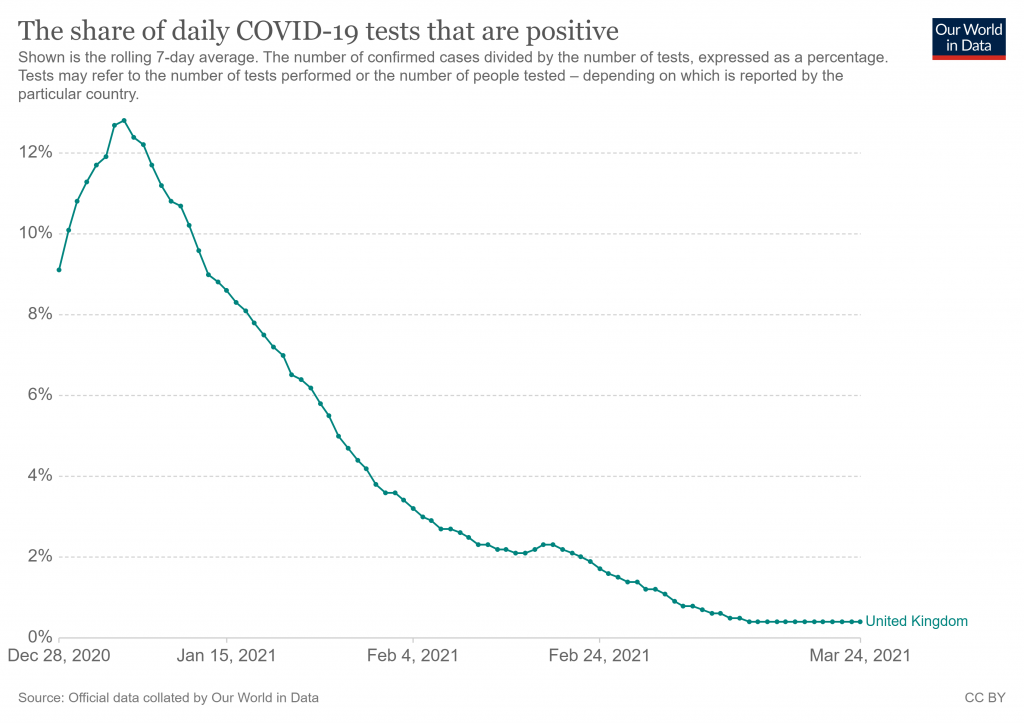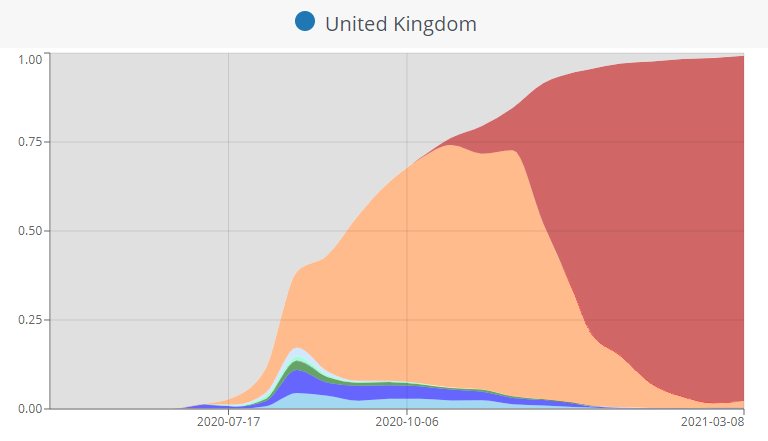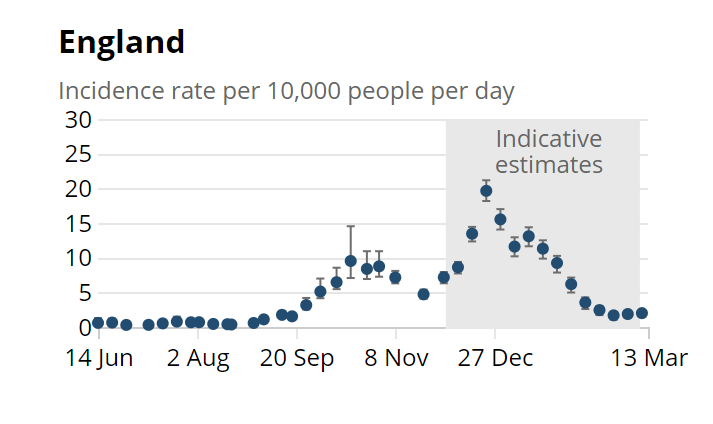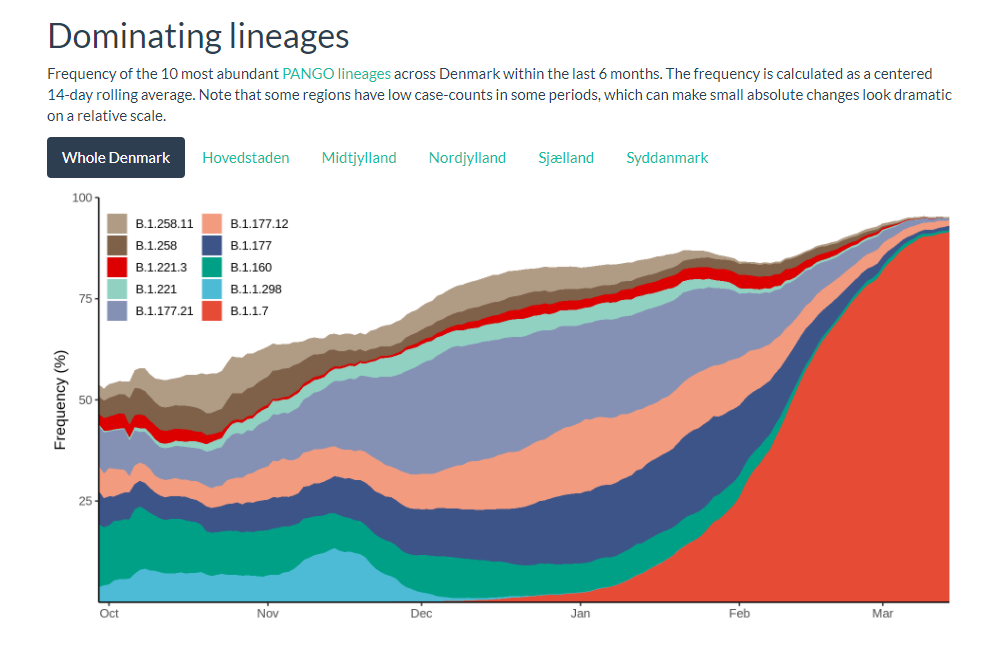One reason that go-slow BoJo is taking his sweet time over lifting lockdown is to allow himself enough time (frankly, more than enough) to see the impact of each change before making the next.
A Covid surge was, naturally, predicted by Government scientific advisers when schools went back in March. Has that happened? Not even a ripple. In fact, since mass testing in schools began in early March the positive rate has hit a floor of 0.4% (presumably a lot to do with the false positive rate). Are any of these advisers embarrassed by their failed predictions that threatened the education of our children? If so, we’ve not heard.

To be fair, in February, SPI-M member Mark Woolhouse (one of the more heretical ones) told MPs he wasn’t expecting a surge as schools returned, since schools don’t drive the epidemic. “One of the stated reasons for keeping schools closed was to avoid some surge in cases when they open – that’s never happened across western Europe,” he said. Which begs the question: why were schools closed to “avoid some surge in cases when they open” if this has never happened? And why now are children subject to wearing masks all day and constant testing and having to self-isolate whenever they (or a classmate) gets a false positive? Is it all “just in case”?
Perhaps more significant, though, is that this no-show of a surge occurred despite the UK being dominated by the British Covid variant, as the graph below shows, which the Government says is more deadly and more contagious.

New ONS data published on Friday (see graph below) shows that new daily infections in the winter peaked around December 26th – 10 days before the lockdown on January 5th that we were told needed to be “tough enough” to contain the new mutant variant.

So, the new variant that was supposed to be 50% more transmissible than its predecessor goes into decline just as it becomes dominant, 10 days before lockdown and immediately after Christmas. This is the opposite of a Christmas surge – it’s a post-Christmas plummet!
No schools surge, no Christmas surge, and the British variant in decline well over a week before lockdown. None of these facts is “right”, none of them fits the mainstream narrative, whereby dangerous new variants are the reason we must stay locked down even as we are vaccinated.
A similar story is repeated in Denmark. Back at the start of February, epidemiologists with their models of doom were sounding the alarm about the coming flood from the British variant, reputedly so contagious that lockdowns could barely contain it. Here’s the alarmist report in Science magazine published on Feb 3rd.
On its face, the curve of COVID-19 infections in Denmark looks reassuring enough. A nationwide lockdown has led numbers to plummet from more than 3,000 daily cases in mid-December 2020 to just a few hundred now. But don’t be fooled. “Sure, the numbers look nice,” says Camilla Holten Møller of the Statens Serum Institute, who heads a group of experts modeling the epidemic. “But if we look at our models, this is the calm before the storm.”
That’s because the graph really reflects two epidemics: one, shrinking fast, that’s caused by older variants of SARS-CoV-2, and a smaller, slowly growing outbreak of B.1.1.7, the variant first recognised in England and now driving a big third wave of the pandemic there. If B.1.1.7 keeps spreading at the same pace in Denmark, it will become the dominant variant later this month and cause the overall number of cases to rise again, despite the lockdown, Holten Møller says. “It is a complete game changer.”
The same is likely happening in many countries without being noticed. But a massive virus-sequencing effort has allowed Denmark, a country of 5.8 million, to track the rise of the new COVID-19 variant more closely than any other country. “All eyes are on Denmark right now,” says Kristian Andersen, an infectious diseases researcher at Scripps Research who is advising the Danish Government. “When it comes to B.1.1.7, is there a way in which… we can prevent the kind of calamity that we have seen in the U.K. and Ireland, for example?” he asks.
The Danish Government had already tightened restrictions in December and January, closing schools, hospitality and leisure, reducing the cap on gatherings from 10 to five and doubling the distancing requirement from one to two metres. Yet the British variant was still, a month later, estimated to be growing exponentially, with R at 1.07.

So what happened after the epidemiologists’ predictions on February 3rd? The British variant did indeed continue to grow in dominance, as the graph above shows. But what about positive cases? Precipitous decline.

Nothing – completely flat from the start of February. Furthermore, far from the “super-contagious” British variant driving a surge as it arrived, its emergence at the start of January coincided with the plummeting of infections.
None of this is right. None of it fits the narrative about a super-contagious, super-deadly British variant. None of it was predicted by the modellers or anticipated by the Government ministers who listen to them.
Perhaps somebody should tell them.











To join in with the discussion please make a donation to The Daily Sceptic.
Profanity and abuse will be removed and may lead to a permanent ban.
So many of societies problems are caused by the people highlighted here.
Odd that the pre-budget visit to Downing St by those Inner Circle of Hell debentures, Bill Gates and Larry Fink, aroused no concerns in our ever vigilant media about foreign or billionaire interference
Someone mentioned that on GB News last week, and the Leftist guest responded with, we have no right to know what they discussed and if you do, you are a conspiracy theorist. Funny how the Left is now in bed with the corporations.
Twas ever thus with Fascism as it is the difference from Communism.
This is the paragraph that really caught my eye:
‘Coban led a very full life, working as Labour-run Hackney’s Cabinet Member for the Environment and fronting the borough’s £61 million mission to tackle climate change.’
First of all what a very grand title, Hackney obviously sees itself as a mini state.
Beyond that here we have a single Labour council pouring tens of millions of pounds down the Net Zero fantasy drain (and I’m sure many Conservative and Lib Dem ones are being similarly profligate) at the same time as the Labour government complains about multi billion pound black holes in the country’s finances.
Perhaps they should join the dots…
“… a single Labour council …” As you say, they’re all at it. Our “climate emergency” was declared in October 2019, to a great fanfare and presentation of a grandiose statement of intent. Time to revisit that.
Tackling climate change is the biggest waste of human resources in the history of mankind. Never has so much been spent to achieve so little.
Indeed. A colossal iniquity.
Coban and the empty-inane wild eye look of a psychopath with the requisite moustache. A grifter, grafter, corrupt and moron. Which is why the fake news loves him.
Coban and Climate Con Fascism. He and his cult are only missing their black and grey uniforms and shiny boots.
I don’t really buy this whole “election interference” thing – people are free to make their minds up with the information available. That said, the left make sure that any “election interference” that might benefit the right is well publicised, while hiding “interference” in the opposite direction.
Labour made a huge and helpful contribution to the recent US elections. They made damn sure Trump and the GOP won the whole shooting match! Thank you, lefties!
I think Cackles deserves credit for most of that. She might well have been worse than Dementia Joe.
It is v difficult to stop the slush funds since they can target the family(ies) instead or just provide cheap penthouse accommodation.
As Farage found, they can even prosecute a staff member for exceeding the legal threshold but not dismiss the MP elected and hold another election.
So what has Gates been doing for years?
Is Keir-Ching! going to tell us what he and Gates were discussing when they met in No.10 a couple of weeks ago?
Or with Boris in 2019. At least Dominic Cummings has been spilling the beans about the fake democracy in a video interview.
An excellent piece of investigative journalism by Charlotte Gill.
Mete Coban is a Turkish Muslim from the chunk of Cyprus seized by Turkey, “Mete” being a variation of the Turkish Muslim name “Mehmet”, for “Mohammed”.
“Mete was encouraged to get into politics by his father when he was 14 “to give back to the community”, after his family moved over to the UK from Cyprus so his brother could get [FREE NHS] medical treatment.”
Strange way to “give back”, as if the Indigenous Brits have benefitted in the slightest…
On holiday in Cyprus the Cyprian Head Chef said he had recently had an operation done in London free gratis via the NHS.
As Tony Bliar is involved you just know it is, to say the least, suspicious.
Donald Trump, the Winston Churchill of our times, will stick climate change up Stamerheddons backside.
And what about all the Labour people sent to the States to help Harris..